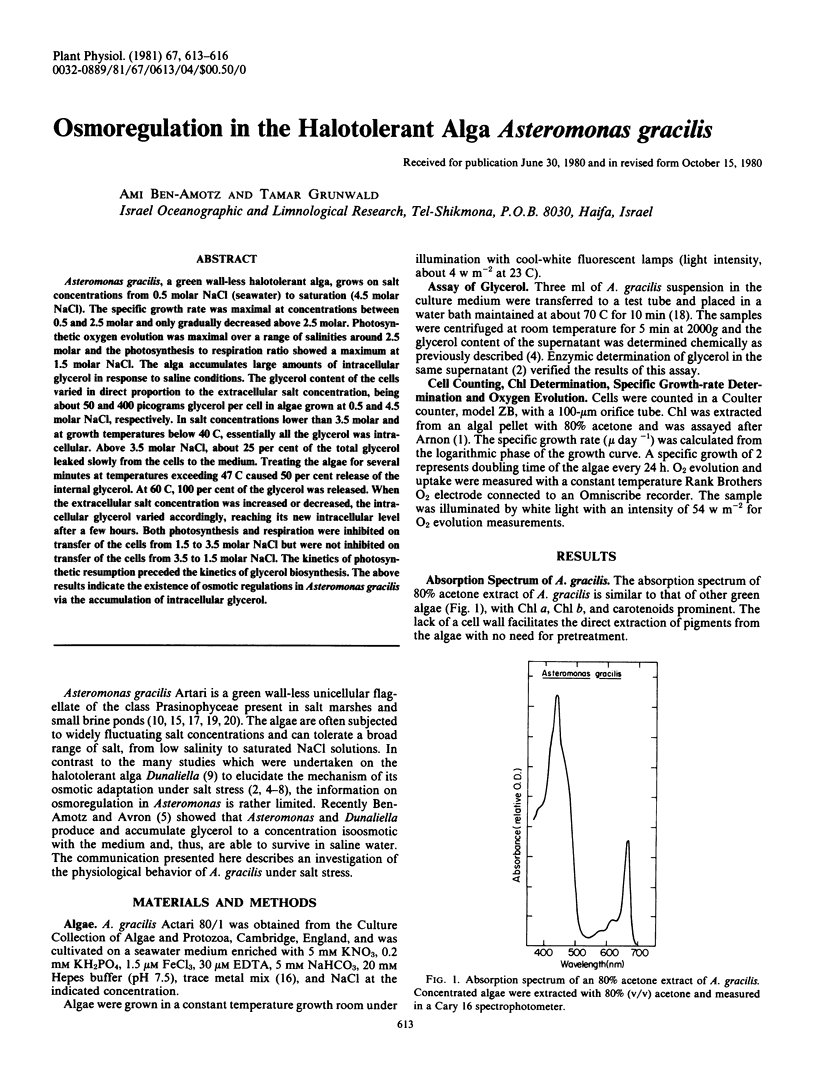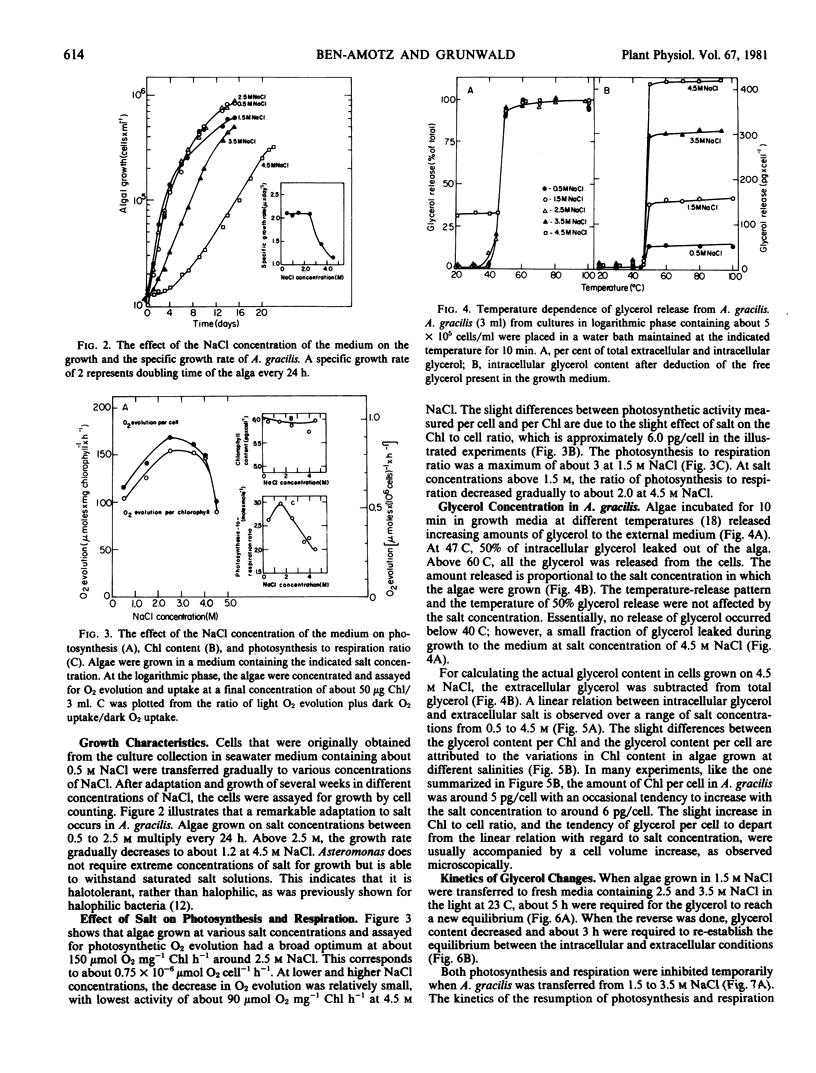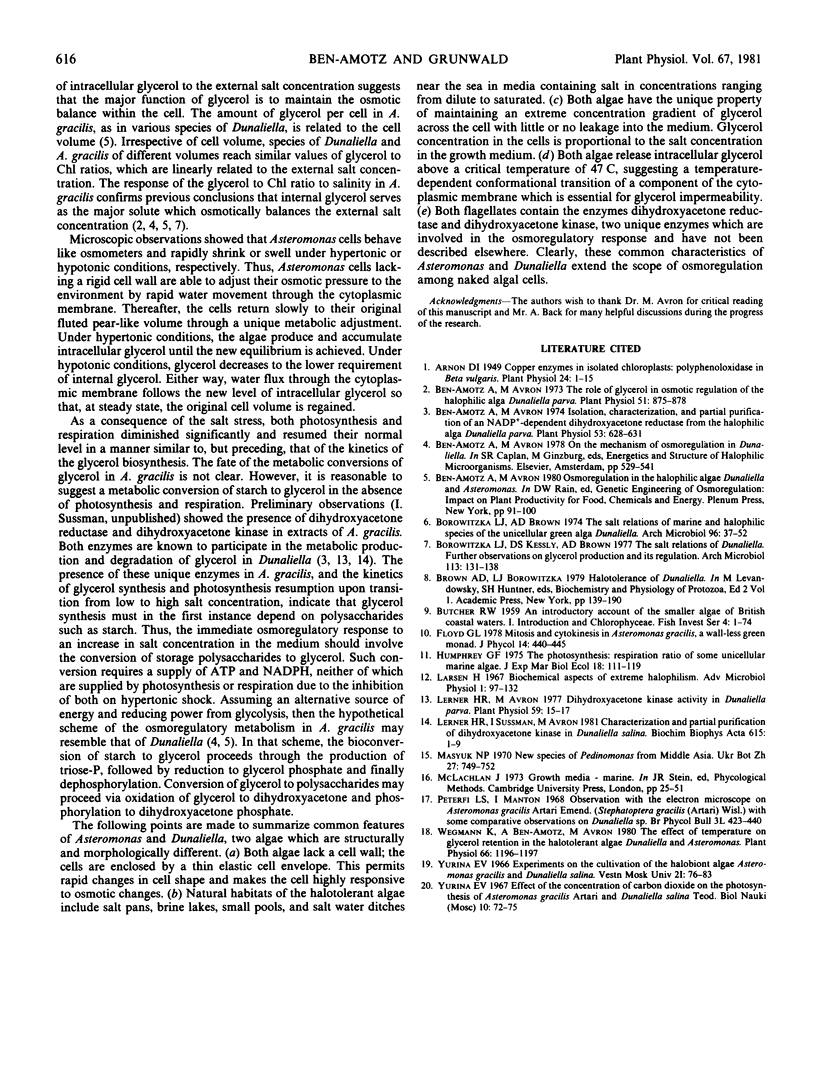Abstract
Asteromonas gracilis, a green wall-less halotolerant alga, grows on salt concentrations from 0.5 molar NaCl (seawater) to saturation (4.5 molar NaCl). The specific growth rate was maximal at concentrations between 0.5 and 2.5 molar and only gradually decreased above 2.5 molar. Photosynthetic oxygen evolution was maximal over a range of salinities around 2.5 molar and the photosynthesis to respiration ratio showed a maximum at 1.5 molar NaCl. The alga accumulates large amounts of intracellular glycerol in response to saline conditions. The glycerol content of the cells varied in direct proportion to the extracellular salt concentration, being about 50 and 400 picograms glycerol per cell in algae grown at 0.5 and 4.5 molar NaCl, respectively. In salt concentrations lower than 3.5 molar and at growth temperatures below 40 C, essentially all the glycerol was intracellular. Above 3.5 molar NaCl, about 25 per cent of the total glycerol leaked slowly from the cells to the medium. Treating the algae for several minutes at temperatures exceeding 47 C caused 50 per cent release of the internal glycerol. At 60 C, 100 per cent of the glycerol was released. When the extracellular salt concentration was increased or decreased, the intracellular glycerol varied accordingly, reaching its new intracellular level after a few hours. Both photosynthesis and respiration were inhibited on transfer of the cells from 1.5 to 3.5 molar NaCl but were not inhibited on transfer of the cells from 3.5 to 1.5 molar NaCl. The kinetics of photosynthetic resumption preceded the kinetics of glycerol biosynthesis. The above results indicate the existence of osmotic regulations in Asteromonas gracilis via the accumulation of intracellular glycerol.
Full text
PDF



Selected References
These references are in PubMed. This may not be the complete list of references from this article.
- Arnon D. I. COPPER ENZYMES IN ISOLATED CHLOROPLASTS. POLYPHENOLOXIDASE IN BETA VULGARIS. Plant Physiol. 1949 Jan;24(1):1–15. doi: 10.1104/pp.24.1.1. [DOI] [PMC free article] [PubMed] [Google Scholar]
- Ben-Amotz A., Avron M. Isolation, Characterization, and Partial Purification of a Reduced Nicotinamide Adenine Dinucleotide Phosphate-dependent Dihydroxyacetone Reductase from the Halophilic Alga Dunaliella parva. Plant Physiol. 1974 Apr;53(4):628–631. doi: 10.1104/pp.53.4.628. [DOI] [PMC free article] [PubMed] [Google Scholar]
- Ben-Amotz A., Avron M. The Role of Glycerol in the Osmotic Regulation of the Halophilic Alga Dunaliella parva. Plant Physiol. 1973 May;51(5):875–878. doi: 10.1104/pp.51.5.875. [DOI] [PMC free article] [PubMed] [Google Scholar]
- Borowitzka L. J., Brown A. D. The salt relations of marine and halophilic species of the unicellular green alga, Dunaliella. The role of glycerol as a compatible solute. Arch Mikrobiol. 1974 Mar 1;96(1):37–52. doi: 10.1007/BF00590161. [DOI] [PubMed] [Google Scholar]
- Borowitzka L. J., Kessly D. S., Brown A. D. The salt relations of Dunaliella. Further observations on glycerol production and its regulation. Arch Microbiol. 1977 May 13;113(1-2):131–138. doi: 10.1007/BF00428592. [DOI] [PubMed] [Google Scholar]
- Lerner H. R., Avron M. Dihydroxyacetone Kinase Activity in Dunaliella parva. Plant Physiol. 1977 Jan;59(1):15–17. doi: 10.1104/pp.59.1.15. [DOI] [PMC free article] [PubMed] [Google Scholar]
- Lerner H. R., Sussman I., Avron M. Characterization and partial purification of dihydroxyacetone kinase in Dunaliella salina. Biochim Biophys Acta. 1980 Sep 9;615(1):1–9. doi: 10.1016/0005-2744(80)90002-9. [DOI] [PubMed] [Google Scholar]
- Wegmann K., Ben-Amotz A., Avron M. Effect of temperature on glycerol retention in the halotolerant algae dunaliella and asteromonas. Plant Physiol. 1980 Dec;66(6):1196–1197. doi: 10.1104/pp.66.6.1196. [DOI] [PMC free article] [PubMed] [Google Scholar]


